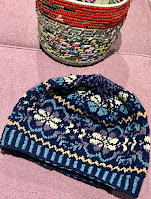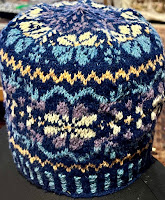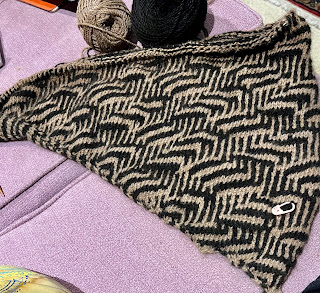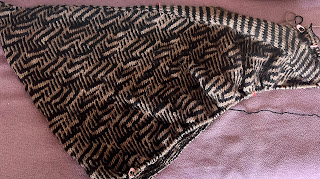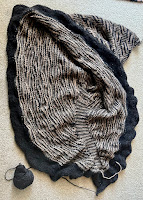 I found these felt doves on the Leprosy Mission website a couple of months ago, and thought they were begging to be embroidered, so I bought 5 of them. When I finished knitting the Christmas beanies, this was my next task. They are, I think, my last 2023 Christmas project.
I found these felt doves on the Leprosy Mission website a couple of months ago, and thought they were begging to be embroidered, so I bought 5 of them. When I finished knitting the Christmas beanies, this was my next task. They are, I think, my last 2023 Christmas project.
A record of my stitching and related activity - mostly smocking and embroidery - and what I am learning along the way.
Search This Blog
Saturday, December 23, 2023
White Christmas Doves
Friday, December 22, 2023
Last hat post for a while - I promise!

 My second was the colour of the pompom. I went for white, partly as a contrast and partly because the white yarn is acrylic and much fluffier than the other colours which are cotton. The cotton tends to droop. I tried the smallest pompom maker, which I haven't used before. I had a near disaster when I accidentally cut through the tie thread by mistake. There were a lot of 2.5cm threads to retrieve and tie together!
My second was the colour of the pompom. I went for white, partly as a contrast and partly because the white yarn is acrylic and much fluffier than the other colours which are cotton. The cotton tends to droop. I tried the smallest pompom maker, which I haven't used before. I had a near disaster when I accidentally cut through the tie thread by mistake. There were a lot of 2.5cm threads to retrieve and tie together! 


Sunday, December 17, 2023
A trio of Santa hats

Monday, December 11, 2023
Santa Hat No1.
The Santas repeat is 11 stitches with one stitch between each, so easy to calculate. I didn’t have white in the 10 ply cotton, so used an acrylic I had acquired somewhere along the line. It adds a bit of dimension, and not a lot of warmth. For the tiny strip of face I used a 10 ply cotton in a gold colour.
I needed to figure out how to do the decreases for the crown, but the diamond shape sets the logic and I did it as I went along. I managed to do it without changing needles or too much awkwardness.
Saturday, December 9, 2023
Three Buggiflooer Beanies

 However, once I got the middle section bordered with orange and navy my fears were allayed. It is amazing how the impact changes as the pattern progresses.
However, once I got the middle section bordered with orange and navy my fears were allayed. It is amazing how the impact changes as the pattern progresses.
Tuesday, December 5, 2023
Buggiflooer Beanie 2
As you might have guessed from my last post, I am on a mission to use up the Smith and Jamieson wool I bought to make their colour way of the Shetland Wool Week Buggiflooer beanie.

Sunday, November 26, 2023
Buggiflooer Beanie 1.
I knitted several of last year's SWW hats, in 4ply cotton that I had in abundance. This year, because The Yarn Trader, my local wool store, had a good range of Jamieson & Smith wool, I decided to try knitting their colour way for this year's hat. The Yarn Trader did not have all the exact colours, but with their help, I got fairly close.
I wanted to finish this before our next World Embroidery Study Group meeting in early December. We are talking about knitting, and a friend and I are giving a presentation on Shetland knitting.
In order to make a clear link to embroidery, I set about working the graph from this knitting pattern in cross stitch.
 It's a bit crazy, but I'm pleased to have worked the chart in two media. It is quite a different approach. It's easy to see why Fair Isle knitters used only two colours per row. The creation of floats on the back of the work adds to the thickness. Two threads add thickness, but not much bulk. More would increase the bulk significantly and risk tangles. When working the pattern in thread on a linen background, you can move where you choose, without carrying threads or increasing bulk. That produces more opportunities.
It's a bit crazy, but I'm pleased to have worked the chart in two media. It is quite a different approach. It's easy to see why Fair Isle knitters used only two colours per row. The creation of floats on the back of the work adds to the thickness. Two threads add thickness, but not much bulk. More would increase the bulk significantly and risk tangles. When working the pattern in thread on a linen background, you can move where you choose, without carrying threads or increasing bulk. That produces more opportunities.Tuesday, November 14, 2023
Nora Shawl
 As with the previous shawl, it began with 3 stitches. I worked about 3" back and forth, increasing at each end of every row until I had enough stitches to join into the round., inserting a 9 stitch steek in the process.
As with the previous shawl, it began with 3 stitches. I worked about 3" back and forth, increasing at each end of every row until I had enough stitches to join into the round., inserting a 9 stitch steek in the process.

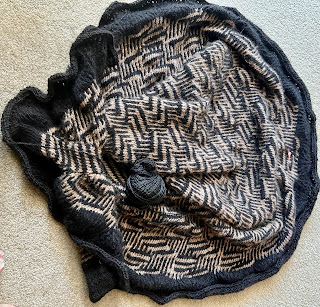


 I was truly delighted with the result. My worry that the edge would continuously curl was unfounded. It folded neatly around the neck and fell beautifully. I was also sceptical about the usefulness of the shape, but it is well long enough to drape comfortably.
I was truly delighted with the result. My worry that the edge would continuously curl was unfounded. It folded neatly around the neck and fell beautifully. I was also sceptical about the usefulness of the shape, but it is well long enough to drape comfortably. 
























